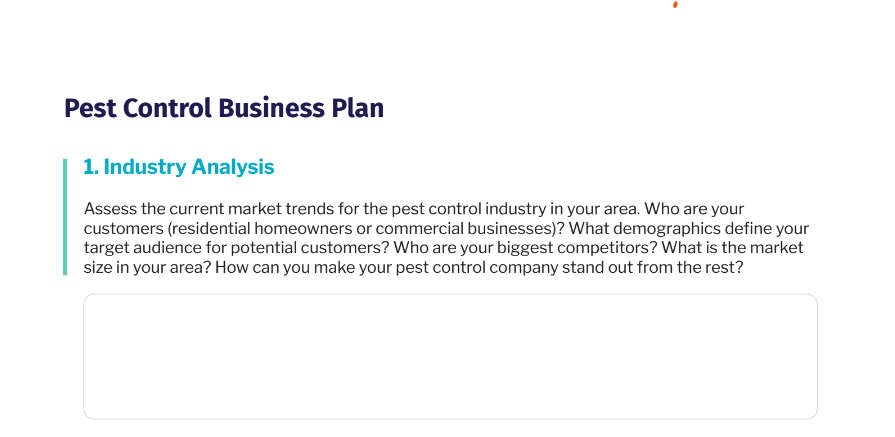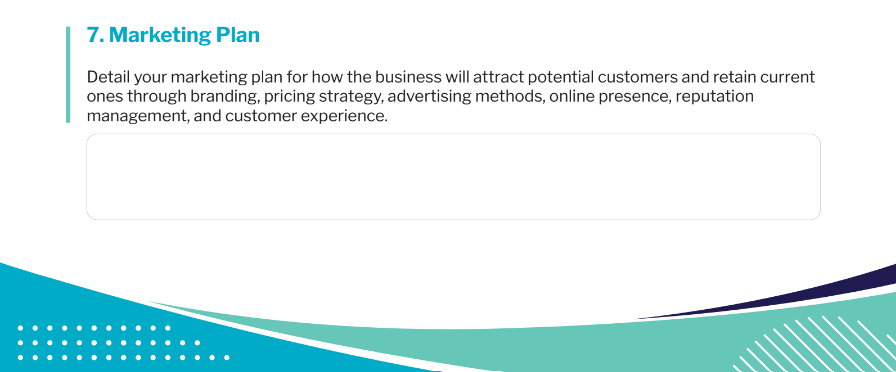Pest Control Business Plan Template (+Free PDF Download)
Whether you’re launching a pest control business or are a seasoned pest control operator, a business plan proves essential to guiding and growing a company. And it’s not something you can create and stick in a drawer. Revisit and adjust your business plan annually.
To create a solid business plan for pest control, many entrepreneurs start with a business plan template tailored to the industry. Read on for a list of the essentials to include in your pest control business plan and a free downloadable business plan template to get started.
Pest Control Business Plan Sample
Download our free editable pest control business plan, save it to your computer, and then customize it for your company.
How to Build a Pest Control Business Plan
Below, we provide an overview of what successful pest control business owners should include in each section of their business plan.
Section 1: Executive summary
The executive summary provides a condensed overview of the entire business plan. It should be concise and attention-grabbing, as this section is the first potential lenders, investors, and partners see when reviewing your business plan.
Within this section, include your pest control company’s mission and vision statements, along with your business goals and objectives. The business goals should illustrate a strategic direction and growth trajectory.
Summarize the most crucial parts of your pest control business plan, such as market opportunities, services offered, and financial projections. Ultimately, you want to entice stakeholders to keep reading your business plan.
Section 2: Business overview
Next, provide a comprehensive overview of your company and its position within the pest control industry at large. Include your company name, service area, and contact information.
Discuss the services you offer and the target market you intend to serve. Go into detail on the types of pest services you offer and the methods and technologies you employ for eradication and prevention.
Clarify whether you provide residential pest control, commercial pest management, or specialized treatments for specific industries, such as hospitality or agriculture.
Finally, list the unique selling propositions that set your business apart from the competition, such as the use of integrated pest management (IPM) methods or 24/7 emergency response. Highlighting your company’s differentiators reinforces its value proposition and strengthens your competitive advantage in the market.
Section 3: Market analysis
Conduct thorough market research to demonstrate your understanding of the pest control industry and your target market. This includes market trends, market size, customer demographics, opportunities, and challenges.

Discuss emerging trends in the pest control industry, such as the prevalence of specific pests, newer treatment methods, and evolving regulations. This illustrates your willingness to anticipate shifts in demand and tailor your services accordingly.
Conduct a competitive analysis to evaluate competitors' strengths and weaknesses, pricing strategies, service offerings, and customer satisfaction levels. This analysis not only helps you differentiate your business but also enables you to capitalize on underserved market segments and anticipate competitive threats.
A comprehensive market analysis empowers you to make informed decisions, optimize resource allocation, and take advantage of growth opportunities within the pest control industry.
Section 4: Organization and management
Next, provide a deep dive into the internal structure of the pest control business, including the qualifications and experience of key personnel. Create an organizational chart to define the responsibilities and reporting relationships associated with each role to ensure clarity and efficiency within the organization.
For the current management team, include brief biographies that list qualifications. This helps personalize your team while instilling confidence in investors and stakeholders.
Outline roles and responsibilities for each job title, as well as any hiring plans connected to growth milestones. Assess the specific skill sets and competencies required for each role to ensure alignment with the company's strategic objectives. Consider factors such as technical proficiency in pest control techniques, leadership abilities, communication skills, and customer relationship management.
Section 5: Services offered
Clearly define the pest control services your company offers, including residential vs. commercial inspection, identification, treatment, and prevention. Also, specify the type of pests your company will or will not treat, such as bedbugs, rodents, or wildlife.
Explain the methodologies and technologies your company employs for effective pest management. Highlight innovative approaches and advanced techniques that differentiate your services from competitors, such as IPM strategies, eco-friendly solutions, or state-of-the-art equipment.

Within this section, include any certifications, licenses, or industry affiliations that demonstrate how your company maintains high service delivery standards and adherence to industry best practices.
Section 6: Marketing and sales strategy
The competitive pest control industry requires an effective marketing and sales strategy for attracting and retaining customers. Discuss the strategies your company plans to use for reaching and engaging its target audience, including traditional advertising (print media, radio, billboards, direct mail), digital marketing (search engine optimization [SEO], email marketing, social media), and community outreach (sponsoring local events, joining neighborhood associations, etc.).
Once you attain customers, outline how you plan to convert them into loyal repeat clients. This may include utilizing a CRM for enhanced communication, creating a membership club, or automating follow-up emails.

By implementing a comprehensive sales and marketing plan, you position your new business for success, effectively reaching potential customers while fostering long-term relationships built on trust and value.
Section 7: Funding requirements
It’s time to talk numbers. Emphasizing transparency and accuracy, this section provides a clear roadmap for securing the necessary capital to support your business objectives.
Whether you’re a startup pest control business or looking to expand, you will likely need capital. For startup costs this may include funds for essential equipment, obtaining licenses and permits, and executing initial marketing campaigns to establish market presence. Established businesses may require funding for expansion into new service areas, technology upgrades, or strategic acquisitions to fuel growth.
When asking investors for funding, be very specific on how much money you need to raise, how it will be used, and the projected return on investment.
Section 8: Financial projections
This section goes hand-in-hand with the previous one. Accurate financial projections demonstrate the viability and sustainability of a pest control business, as well as its ability to pay lenders back on time.
Create realistic revenue forecasts based on market demand, pricing strategies, and growth projections. Take into account the cost of running the business, such as marketing, personnel, and operating expenses. If needed, consult a financial planner to assist with these projections.
Include a profitability analysis showcasing how the business aims to generate positive returns over time. Highlight key performance indicators such as gross margin, net profit margin, and return on investment to demonstrate the financial health and sustainability of your venture.
For already established businesses, include the previous year’s financial statements, including a balance sheet and cash flow statement.
Section 9: Risk analysis
Every business comes with inherent risks. For the pest control industry, those are often related to environmental concerns, pest resistance, and regulatory changes. Create a plan for how you will anticipate and mitigate the effects of these risks.
Consider challenges that come with day-to-day operations, such as employee safety hazards, equipment malfunctions, and fluctuating demand due to seasonal variations. Outline preventive measures and protocols to minimize the likelihood of accidents, ensure compliance with safety regulations, and maintain operational continuity.
While it sounds like a misnomer, plan for the unplanned events that could disrupt business operations, like natural disasters, supply chain disruptions, or public health emergencies. A robust contingency plan proves essential to minimizing the impact these events have on your operations.
By proactively identifying, assessing, and addressing potential risks, you demonstrate your commitment to safeguarding your company’s long-term success.
Section 10: Regulatory compliance
In the pest control industry, adhering to regulatory standards, particularly involving the use of pesticides, is paramount. Depending on the location you serve and the pest control solutions you provide, your company may be required to obtain state or local licenses, applicator certifications, and permits for handling and applying pesticides.
Abiding by these regulations not only promotes safety but also showcases your commitment to professionalism and minimizing environmental impacts. In turn, your pest control business can cultivate a reputation for integrity, reliability, and responsible stewardship.
Invest in continuing education for your team members so your business stays on top of industry trends and requirements.
Section 11: Implementation plan
Now it’s time to show how you’ll take your business plan off of paper and make it a reality. Create a realistic timeline for the implementation of each aspect of your business plan. Discuss how resources, including personnel, technology, and finances, will be allocated to ensure a smooth business plan execution.
Outline key milestones to track progress and measure success along the way. Whether it's securing necessary licenses, launching marketing campaigns, or achieving revenue targets, mark these milestones as indicators of success.
A well-defined implementation plan offers a roadmap for translating strategic objectives into actionable steps, ensuring alignment, accountability, and progress toward realizing the vision for your pest control business.
Set Your Pest Control Business Up for Success With the Right Technology
In order to implement a pest control business plan effectively, you need tools to optimize operations and measure success. FieldRoutes, a business management platform built for the pest control industry, provides software to help pest control operators simplify, scale, and grow.
From drag-and-drop scheduling to intelligent routing and comprehensive reporting, the user-friendly software automates key business processes. Whether you’re a small company looking to grow or a larger business seeking to optimize operations, FieldRoutes delivers what you require in its end-to-end business management solution.
Schedule a free demo today to learn how FieldRoutes can help your pest control business unlock growth.
Frequently Asked Questions (FAQs)
Still, have questions about creating a pest control business plan? Check out these frequently asked questions and answers.
Q1. Why do you need a pest control business plan?
A pest control business plan guides operations, ensuring that the business trajectory aligns with the intended mission and vision. For companies seeking funding, investors will want to see a comprehensive business plan to assess business viability and potential returns.
Q2. How do you get funding for your pest control business?
To secure funding for your pest control business, explore options like acquiring small business loans or partnering with investors. Present a compelling business plan detailing your market analysis, financial projections, and growth strategy to attract potential investors or lenders.
Q3. Is pest control a profitable business?
In general, profitability hinges on factors such as market demand, competitive pricing, efficient operations, and effective marketing strategies. The average profit margin for pest control companies in the U.S. ranges from 10 to 20%, according to FinModelsLab, a leading provider of financial tools and resources for startups and small businesses.